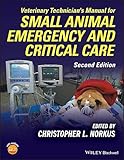Veterinary technician's manual for small animal emergency and critical care / edited by Christopher L. Norkus.
Publisher: Hoboken, NJ : Wiley, 2018Edition: Second editionDescription: 1 online resourceContent type:- text
- computer
- online resource
- 9781119179122
- 1119179122
- 9781119179115
- 1119179114
- 9781119536598
- 1119536596
Includes bibliographical references and index.
'This book provides an in-depth and cutting-edge, yet easy-to-navigate, reference on emergency and critical care for veterinary paraprofessionals of all skill levels'--Provided by publisher.
Description based on print version record and CIP data provided by publisher.
Intro; Title Page; Copyright Page; Contents; Contributors; Foreword; Preface; Acknowledgment; About the Companion Website; Section 1 Initial Patient Management; Chapter 1 Triage and Initial Assessment of the Emergency Patient; Introduction; Myth Versus Reality: When Do Emergencies Strike?; Triage; Primary Assessment and Patient History; Secondary Assessment; Unique Triages; Mass Casualty Incidents and Disaster Triage; Tactical and Working Canines; References; Chapter 2 Shock and Initial Stabilization; Introduction; Oxygen Delivery and Extraction; Hypoxia and'Shock'; Initial Stabilization
Initial DiagnosticsResuscitation Endpoints; Acknowledgment; References; Chapter 3 Venous Access; Introduction; Catheter Types; Intraosseous Catheterization; Catheter and Vein Selection; Catheter Maintenance; Complications; References; Chapter 4 Monitoring the Critical Patient; Introduction; Record Keeping; The Art and Practice of Monitoring; Monitoring without Monitors; Integrated Monitoring; Frequently Used Monitoring Equipment; Conclusion; References; Chapter 5 Cardiopulmonary Resuscitation; Introduction; Coronary Perfusion Pressure; Managing and Recognizing CPR Needs; Early Interventions
Basic Life SupportAdvanced Life Support; Return of Spontaneous Circulation; Postresuscitation Care; References; Section 2 Specific Organ System Disorders; Chapter 6 Cardiovascular Emergencies; Introduction; Anatomy of the Pericardium and Heart; Cardiac Action Potential Generation; Electrical Conductance; The Cardiac Cycle; Blood Pressure and Delivery of Oxygen to Tissue; Pathophysiology of Heart Failure; Emergency Treatment of Heart Failure; Cardiovascular Nursing; Specific Cardiac Emergencies; Cardiac Arrhythmia; Cardiac Arrest Rhythms; References; Chapter 7 Respiratory Emergencies
IntroductionAnatomy of the Respiratory System; Respiratory Physiology; Causes of Hypoxia; Causes of Hypoxemia; Assessment of Oxygenation and Ventilation; Specific Respiratory Disorders; References; Chapter 8 Gastrointestinal, Hepatobiliary, and Pancreatic Emergencies; Introduction; Anatomy and Physiology of the Gastrointestinal Tract; Physiology of Emesis; Assessment of the Gastrointestinal Emergency; Specific Gastrointestinal Disorders; References; Chapter 9 Urogenital Emergencies; Introduction; Renal Anatomy; Renal Physiology; Azotemia; Acute Kidney Injury Staging Systems
Nursing Care of the Renal PatientTraditional Therapies; Advanced Therapies; References; Chapter 10 Endocrine and Metabolic Emergencies; Introduction; Anatomy and Physiology of the Endocrine System; Specific Endocrine Diseases; References; Chapter 11 Hemolymphatic, Immunological, and Oncology Emergencies; Introduction; Physiology of Blood Components; Blood Component Disorders; The Immune System; Immune System and Oncology Disorders; Physiology of Hemostasis; Laboratory Assessment of Hemostasis; Hemostatic Testing Modalities; Hemostatic Disorders; The Lymphatic System; References
There are no comments on this title.

